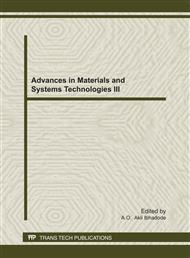[1]
Amadi, A. Unsafe waste disposal practices in Nigerian cities: Geoenvironmental perspectives. Nigerian Society of Engineers (NSE) Technical Transactions, Vol. 42, No. 2, 2007, 31 – 44.
Google Scholar
[2]
Bowders, T. J. Jr. and Daniel, D. E. Hydraulic conductivity of compacted clay to dilute organic chemicals, J. Geotech. Eng., Vol. 113, No. 12, 1987, 1432 – 1448.
DOI: 10.1061/(asce)0733-9410(1987)113:12(1432)
Google Scholar
[3]
Fernandez, F. and Quigley, R. M. Hydraulic conductivity of natural clays permeated with simple liquid hydrocarbons, Can. Geotech. J., Vol. 22, 1985, 205 – 214.
DOI: 10.1139/t85-028
Google Scholar
[4]
Kaya, A. and Fang, H. Y. Effects of organic fluids on physico-chemical parameters of fine grained soils. Can. Geotech. J., Vol. 37, No. 5, 2000, 943 – 950.
DOI: 10.1139/t00-023
Google Scholar
[5]
Broderick, G. and Daniel, D. Stabilizing compacted clay against chemical attack. J. Geotech. Eng., Vol. 116, No. 10, 1990, 1549 – 1566.
DOI: 10.1061/(asce)0733-9410(1990)116:10(1549)
Google Scholar
[6]
Mitchell, J. K. Fundamentals of Soil Behaviour. 2nd Ed. John Wiley & Sons, Inc., New York, (1993).
Google Scholar
[7]
Anderson, D. Does Landfill Leachate Make Clay Liners More Permeable?. Civil Engineering, Vol. 52, No. 9, 1982, 66 – 69.
Google Scholar
[8]
Fernandez, F. and Quigley, R. M. Viscosity and Dielectric Constant controls on the Hydraulic Conductivity of Clayey Sols Permeated with Water soluble Organic Chemicals. Canadian Geotech. J., Vol. 25, 1988, 582 – 589.
DOI: 10.1139/t88-063
Google Scholar
[9]
Oweis, I. S. and Khera, R. P. Geotechnology of Waste Management. 2nd edition PWS publishing company Singapore, (1988).
Google Scholar
[10]
Shackelford, C. D., Benson, C. H., Katsumi, T., Edil, T. B., Lin, L. "Evaluating the Hydraulic Conductivity of GCLs Permeated with Non – Standard Liquids. Geotextiles and Geomembranes, Elsevier 18: Amsterdam, 2000, 137 – 161.
DOI: 10.1016/s0266-1144(99)00024-2
Google Scholar
[11]
BS 1377 Methods of Tests for soils for Civil Engineering Purposes, British Standards Institutions, London, (1990).
Google Scholar
[12]
Head, K. H. Manual for Soil Laboratory Testing, Vol. I. Soil Classification and Compaction Tests. Halsted Press, New York, (1994a).
Google Scholar
[13]
Head, K. H. Manual of soil laboratory testing. Permeability, Shear Strength and Compressibility Tests, 2nd Ed. Vol. 2, Pentech Press, London, (1994b).
Google Scholar
[14]
Mesri, G. and Olson, R. Mechanisms controlling the permeability of clays,. Clay and Clay minerals, Vol. 19, 1971, 151-158.
DOI: 10.1346/ccmn.1971.0190303
Google Scholar
[15]
Osinubi, K. J. and Amadi, A. A. Hydraulic performance of compacted lateritic soil – bentonite mixtures permeated with municipal solid waste landfill leachate. Transportation Research Board (TRB) 88th Annual meeting CD-ROM, 11-15th Jan., 2009, Washington DC, USA. 2009, 1-18.
DOI: 10.1061/9780784480144.048
Google Scholar
[16]
Benson, C. H., Zhai, H. and Wang, X. Estimating hydraulic conductivity of compacted clay liners, J. Geotech Engrg ASCE, Vol. 120, No. 2, 1994, 366-387.
DOI: 10.1061/(asce)0733-9410(1994)120:2(366)
Google Scholar
[17]
Adams, R. H.; Guzman-Osorio, F. J.; Zavala Cruz, J. Water repellency in oil contaminated sandy and clayey soils. Int. J. Envron. Sci. Tech., Vol. 5, No. 4, 2008, 445 – 454.
DOI: 10.1007/bf03326040
Google Scholar
[18]
Ariyo, M. O. The Effects of Organic Chemicals on the Mechanical Properties of Lateritic Soil stabilized with Cement Kiln Dust. Unpublished thesis at the Department of Civil Engineering, Federal University of Technology, Minna, Nigeria, (2010).
Google Scholar


